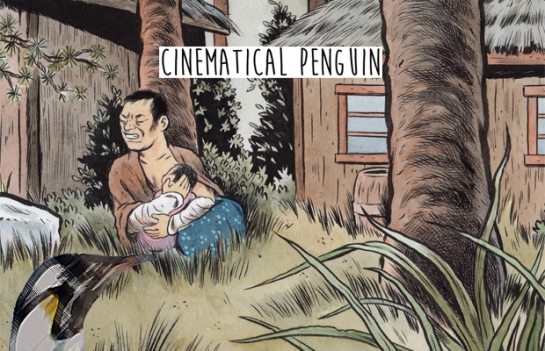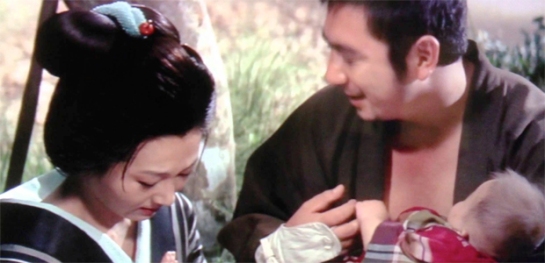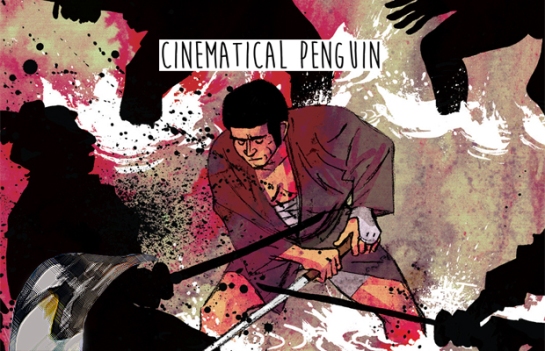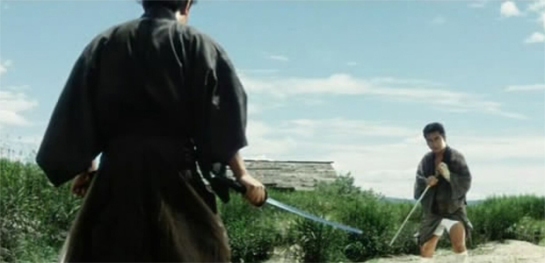Year: 1964
Director: Kenji Misumi
Writer: Seiji Hoshikawa, Tetsuro Yoshida, Masaatsu Matsumura,(based on a short story by Kan Shimozawa)
Starring: Shintaro Katsu, Hizuru Takachiho, Nobuo Kaneko, Gen Kimura, Shosaku Sugiyama, Ikuko Mori,
Misumi returns to the series for the first time since the film that started it all. Although his presence isn’t as noticeable as when some director’s came in and added stylistic flourishes, what is easy to notice is how restrained the ironically titled Fight, Zatoichi, Fight is. Despite that title, the film is the least violent of the efforts so far, mostly due to the main plot which sees Zatoichi trying to deliver a baby home to its father. This story means that Zatoichi must avoid fights in order to complete his mission, but the declarative title is how his adversaries (and perhaps the audience) feel. Violence doesn’t leave Zatoichi alone, he is a violence magnet despite his calm and caring nature.
The calm and caring aspects of the blind swordsman are what are really on show here. He comes into possession of a baby after he offers a ride in a palanquin to a struggling young woman. Unfortunately a gang of hired assassins have already seen Zatoichi in said palanquin and run it through assuming they have struck their target. This kind of cruel fate constantly haunts Zatoichi, and so he decides to take a road trip with the child. It’s a slower tale than others, but one that fully allows Katsu to show off his comedic talents. The bonding between Zatoichi and the baby has none of the mawkishness or sentiment that would be so easy to attribute to such a film. Instead, it’s displayed as a learning process, as Zatoichi begins to understand the child. It also brings out Zatoichi’s playful side, and it’s nice to see that he never once plays the role as a gruff cold hearted Grinch.
The villains are kept very simple in this 8th adventure, and it works very well. Having generic villains can work when they are not necessary to the plot. The sense of threat is always out there, but watching Zatoichi grow is far more important. His character is also defined in scenes such as when he protects a young female pickpocket from one of her victims. He refuses to cover up for the lady’s indiscretions, but also aids her enough to avoid any violence. Despite the legend behind the man, and the reason we all flock to a Zatoichi film, he is not gung-ho and would probably give up his sword at the first available chance.
The scene builds nicely towards its inevitable conclusion, which sees a beautifully constructed showdown that utilises fire. As his enemies surround him, Zatoichi once again comes across as a mythical monster who inhabits the nightmares of evildoers. It shows that Misumi has not lost his touch, and his later adventures in the Sleepy Eyes Of Death and Lone Wolf And Cub franchises would prove this should it have needed proving. This is a stripped down Zatoichi experience that shows that despite Hollywood’s insistence to “go big or go home” as far as sequels go, sometimes a deep breath and bit of patience can go a lot further.
Will I enjoy it?
This will certainly appeal to fans of the character more than fans of samurai action features. There’s a strong maternal vibe that flows through the film and results in a lot of heart. The bonding sequences far outweigh the fights, although those are worth the wait if that’s what you’re mostly interested in. Anyone who’s ever laughed at a Zatoichi film before will probably enjoy the slower sections.







